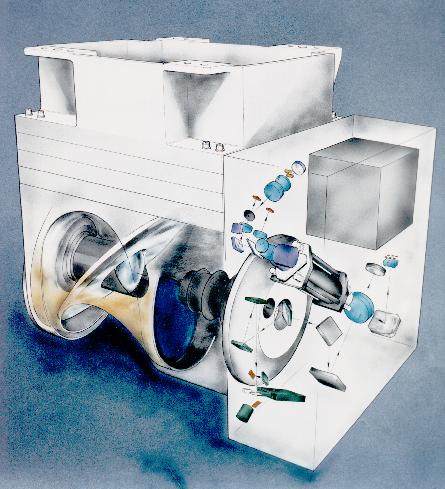
MGS Thermal Emission Spectrometer
(Optics arrangement)
3 Instruments in 1
TES has three subsections that measure incoming infrared and visible energy: a Michelson interferometer, a broadband radiance sensor, and a solar reflectance sensor. The interferometer is at the heart of the thermal IR spectrometer portion of TES. It covers the wavelength range from 6 to 50 microns (~1650-200 cm-1) with 5 and 10 cm-1 spectral sampling (~10 and 20 cm-1 resolution). The broadband sensor measures radiance in a single band from 5.5 to 100 microns. To measure the brightness of reflected solar energy, a third sensor views the planet in the 0.3 to 2.7 micron region. Each sensor has six detectors arranged in a 3 by 2 array, each with a field of view of 8.3-mrad. This translates to a spatial resolution of 3 km from the MGS orbit. The entire TES instrument is about the size of a small microwave (24 x 35 x 40 cm) and weighs 32 lbs (14.4 kg). TES is powered by the spacecraft's solar cells using only 14.5 watts (about 1/3 the power of a refrigerator lightbulb).
Squiggly Lines and Strange Pictures
Because the TES spectrometer has a 3 by 2 array of detectors, it is capable of producing two-dimensional images of Mars' surface in addition to emissivity spectra. As the MGS spacecraft flys along in its orbit, TES measures a strip along the ground that is three pixels (picture elements) wide. Each pixel represents the field of view of a detector, which means that TES will be able to see a 3 by 3 km (1.9 by 1.9 mi) spot on the ground. The long narrow strips of TES data can be joined side by side with strips from other orbits to make pictures. To make visible pictures from invisible light, three wavelength regions of the infrared spectrum are assigned to the colors red, green, and blue. In this way, each TES pixel can be colored. The result is a false color image of the infrared energy emitted from Mars' surface.



